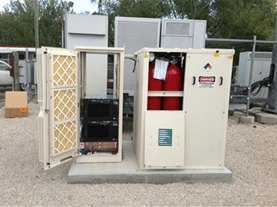
What do you get when you cross a fuel cell with a cell tower? Would that be a fuel tower? Or perhaps a fuel cell cell tower? Probably the best people to ask would be the folks at Sprint since they just received a grant from the U.S. Department of Energy to install hydrogen fuel cell (HFC) technology as backup power to a number of their network sites.
The technology, still in development, would actually provide innovative approaches for rooftop fuel cell deployments. One approach being explored is a modular and lightweight fuel cell solution that can be installed without cranes and can be refueled from the ground – eliminating the need to transport fuel to rooftops.
The company proposed the use of fuel cells as a cleaner alternative to the more common diesel-powered backup generators, citing them as a way to avoid greenhouse gas emissions (GHG), the risk of ground contaminants and higher maintenance costs. Unlike fossil fuel-based generators, HFCs generate electricity with no environmentally undesirable greenhouse gas emissions. As a company, Sprint strives to limit the deployment of new fossil fuel generators. Sprint is working to reduce its GHG emissions by an absolute 20 percent by 2017.
The full scope and financial structure of the project is yet to be determined, but details are expected in the next 60 days. Sprint hopes to begin installing the fuel cells by the end of 2014. The primary desired outcome of the program is to develop economically and operationally viable methodologies that can be scaled up for a widespread deployment of rooftop fuel cell backup systems. Both Sprint and the DOE hope this can also promote further hydrogen fuel cell advancement across a multitude of industries.
Besides lower emissions, the fuel cell approach should allow for lower network site maintenance, which should increase network survivability during power outages -- a critical performance indicator in this industry. The fuel cell-based systems also have a life expectancy of 20 years, considerably longer than diesel systems, and they require less battery reserve power (only 8 minutes, instead of 2 hours).
It wasn't clear from the announcement where the hydrogen would come from or how the total cost of operation is expected to compare with the more conventional backup systems.
"We are excited to once again partner with the DOE to bring a new fuel cell technology solution to the market," said Bob Azzi, chief network officer at Sprint. "To date, we’ve deployed approximately 500 hydrogen fuel cells in our network. This technology will provide backup power for our network and could extend to other industries as well."
Sprint and the DOE have worked together previously to deploy hydrogen fuel cells as an energy source for their network. Sprint pioneered the introduction of fuel cell technology to ground-based networks in 2005. In 2009 the DOE provided a $7.3 million grant for Sprint to support fuel cell technology advances including the development and testing of a 72-hour emergency backup system. Rooftop cell sites comprise almost 25 percent of Sprint’s total network locations for which fuel cells have not been an option for deployment until now. As much as 30 percent of total network cell sites are located on rooftops in some major metropolitan areas.
Compass Intelligence recently named Sprint as the most "eco focused" wireless carrier. The company has been widely recognized for its environmental commitments to decrease energy use, enable more eco-friendly mobile solutions and offer industry-leading wireless recycling programs.
Last year, Sprint was the only telecommunications company named to CDP’s S&P 500 Climate Performance Leadership Index (CPLI), which highlights companies that demonstrate strategies committed to improving their impact on the environment. Sprint was also named for the third consecutive year to the Dow Jones Sustainability Index (DJSI) North America, which tracks the corporate sustainability performance of the top 20 percent of the 600 largest companies by industry in the United States and Canada.
Cell tower image: EMFNews.com/Flickr Creative Commons
Fuel cell image: Sprint
RP Siegel, PE, is an inventor, consultant and author. He co-wrote the eco-thriller Vapor Trails, the first in a series covering the human side of various sustainability issues including energy, food, and water in an exciting and entertaining format. Now available on Kindle.
Follow RP Siegel on Twitter.

RP Siegel (1952-2021), was an author and inventor who shined a powerful light on numerous environmental and technological topics. His work appeared in TriplePundit, GreenBiz, Justmeans, CSRWire, Sustainable Brands, Grist, Strategy+Business, Mechanical Engineering, Design News, PolicyInnovations, Social Earth, Environmental Science, 3BL Media, ThomasNet, Huffington Post, Eniday, and engineering.com among others . He was the co-author, with Roger Saillant, of Vapor Trails, an adventure novel that shows climate change from a human perspective. RP was a professional engineer - a prolific inventor with 53 patents and President of Rain Mountain LLC a an independent product development group. RP was the winner of the 2015 Abu Dhabi Sustainability Week blogging competition. RP passed away on September 30, 2021. We here at TriplePundit will always be grateful for his insight, wit and hard work.














